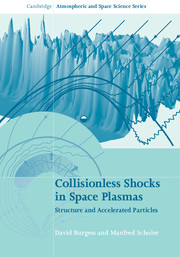Book contents
- Frontmatter
- Contents
- Preface
- Chapter 1 Shocks
- Chapter 2 Basic concepts
- Chapter 3 The quasi-perpendicular shock: macrostructure
- Chapter 4 The quasi-perpendicular shock: microstructure
- Chapter 5 The quasi-parallel shock
- Chapter 6 Diffusive shock acceleration
- Chapter 7 Coherent shock acceleration
- Chapter 8 Electron acceleration
- Chapter 9 Global and modified shocks
- Appendix Simulation techniques
- References
- Further reading
- Index
Chapter 8 - Electron acceleration
Published online by Cambridge University Press: 05 August 2015
- Frontmatter
- Contents
- Preface
- Chapter 1 Shocks
- Chapter 2 Basic concepts
- Chapter 3 The quasi-perpendicular shock: macrostructure
- Chapter 4 The quasi-perpendicular shock: microstructure
- Chapter 5 The quasi-parallel shock
- Chapter 6 Diffusive shock acceleration
- Chapter 7 Coherent shock acceleration
- Chapter 8 Electron acceleration
- Chapter 9 Global and modified shocks
- Appendix Simulation techniques
- References
- Further reading
- Index
Summary
Observations
The evidence from the Earth's bow shock and other solar system shocks is that collisionless shocks, at least for the observed parameter range, are not characterized by strong electron heating. Similarly, they are generally not responsible for strong electron acceleration, either in terms of fluxes or maximum energy. On the other hand, there is clear observational evidence for some shock acceleration of electrons to moderate energies at the bow shock and at interplanetary shocks. In both cases there is an electron foreshock populated by superthermal, energized electrons. The average thermal speed of the solar wind electron distribution is approximately 2000 km s–1 that the speed of electrons accelerated to only a few thermal energiesis much greater than the solar wind convection speed. Consequently the upstream edge of the electron foreshock can be taken as the tangent surface of magnetic field lines touching the shock surface. Accelerated ions, with their relatively slower speeds, are more affected by the solar wind convection and swept downstream. Thus, there is a region, downstream of the magnetic field tangent line surface and upstream of the ion foreshock, which can only be accessed by shock-accelerated electrons. This part of the electron foreshock, magnetically connected to the quasi-perpendicular shock, has the advantage, in terms of analysis, of not being disturbed by waves driven by accelerated ions. Direct particle observations at the electron foreshock at the Earth's bow shock gives evidence of shock acceleration from suprathermal energies to tens of keV. A review of electron foreshock observations and models is given by Fitzenreiter (1995).
Apart from direct measurements, the presence of energetic electrons can be inferred from the observations of Langmuir turbulence and other plasma waves driven via electron beams instabilities. At the Earth the electron foreshock is also a radio source at first and second multiples of the local plasma frequency, so-called fp and 2fp emission. Here the generation mechanism depends on electron beams which drive electrostatic Langmuir waves with frequency close to fpe via a beam instability. Some of the Langmuir wave energy is converted into fp and 2fp radiation by various linear or nonlinear wave–wave processes (Melrose, 1986). The fact that foreshock radio emission can be related to shock acceleration of electron beams gives the opportunity for remote sensing or characterizing shocks on larger scales than observable by a single spacecraft.
- Type
- Chapter
- Information
- Collisionless Shocks in Space PlasmasStructure and Accelerated Particles, pp. 278 - 295Publisher: Cambridge University PressPrint publication year: 2015



